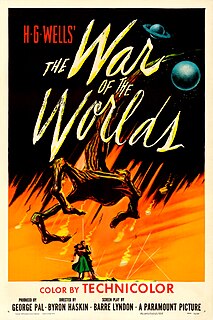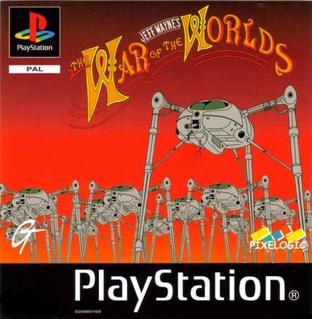The War of the Worlds is an 1898 science fiction novel by H. G. Wells.

A Martian is an inhabitant of the planet Mars or a human colonist on Mars. Although the search for evidence of life on Mars continues, many science fiction writers have imagined what extraterrestrial life on Mars might be like.

Jeff Wayne's Musical Version of The War of the Worlds is the debut album by Jeff Wayne, retelling the story of The War of the Worlds by H. G. Wells. It was released in the UK on 9 June 1978. A concept album and a rock opera, its main format is progressive rock and string orchestra, using narration and leitmotifs to carry the story and rhyming melodic lyrics that express the feelings of the various characters. The two-disc album remains a bestseller, having sold 15 million copies worldwide. In 2018, it was named the 32nd best-selling studio album of all time in the UK. It has spawned multiple versions including video games, DVDs, and live tours.

Jeffry Wayne is an American-born naturalized British composer, musician and lyricist. In 1978, he released Jeff Wayne's Musical Version of The War of the Worlds, his musical adaptation of H. G. Wells' science-fiction novel The War of the Worlds. Wayne wrote approximately 3,000 advertising jingles in the 1970s which appeared on television in the United Kingdom, notably a Gordon's Gin commercial which was covered by The Human League. Wayne also composed numerous well-known television themes, including Good Morning Britain (TV-am), ITV's The Big Match and World of Sport, BBC's Sixty Minutes, and for 24 years, the UK's first news radio station, LBC.

H. G. Wells' War of the Worlds, also known as Invasion and H. G. Wells' The Worlds in War internationally, or simply as War of the Worlds, is a direct-to-DVD science fiction war film produced by The Asylum and directed by David Michael Latt. It is a loose adaptation of the H. G. Wells 1898 novel The War of the Worlds, and a mockbuster of the DreamWorks/Paramount film based on the same source.
HMS Thunder Child is a fictional ironclad torpedo ram of the Royal Navy, destroyed by Martian fighting-machines in H. G. Wells' 1898 novel The War of the Worlds whilst protecting a refugee rescue fleet of civilian vessels.

The fighting machine is one of the fictional machines used by the Martians in H.G. Wells' 1898 classic science fiction novel The War of the Worlds. It is a fast-moving, three-legged walker, reported to be 100 feet tall, with multiple whip-like tentacles used for grasping, and two lethal weapons: the Heat-Ray and a gun-like tube used for discharging canisters of a poisonous chemical black smoke that kills humans and animals. It is the primary machine the Martians use when they invade Earth, along with the handling machine, the flying machine, and the embankment machine.
The Flying machine is one of the fictional machines used by the Martians in H. G. Wells' classic 1898 science fiction novel The War of the Worlds. It is one of the four types of heavy machine the Martians bring with them when they invade Earth, along with the fighting machine, the handling machine, and the embankment machine.

The First Men in the Moon is a scientific romance by the English author H. G. Wells, originally serialised in The Strand Magazine from December 1900 to August 1901 and published in hardcover in 1901, who called it one of his "fantastic stories". The novel tells the story of a journey to the Moon undertaken by the two protagonists: a businessman narrator, Mr. Bedford; and an eccentric scientist, Mr. Cavor. Bedford and Cavor discover that the Moon is inhabited by a sophisticated extraterrestrial civilisation of insect-like creatures they call "Selenites".

The Martians, also known as the Invaders, are the fictional race of extraterrestrials from the H.G. Wells 1898 novel The War of the Worlds. They are the main antagonists of the novel, and their efforts to exterminate the populace of the Earth and claim the planet for themselves drive the plot and present challenges for the novel's human characters. They are notable for their use of extraterrestrial weaponry far in advance of that of mankind at the time of the invasion.

"The Crystal Egg" is a science fiction short story written by H. G. Wells in 1897.
The Embankment machine is one of the fictional machines used by the Martians in the H. G. Wells' classic 1898 science fiction novel The War of the Worlds. It is an excavator, and is one of the four types of machine the Martians bring with them when they invade Earth, the three others being the fighting machine, the flying machine, and the handling machine.

H. G. Wells' The War of the Worlds is the first of three reworked direct-to-video film versions, first appearing in 2005, that adapts H. G. Wells's 1898 novel of the same name about a Martian invasion of southern England. This version, noted for its faithfulness to Wells's novel, was produced by the independent film company Pendragon Pictures. Unlike the adaptations set in the current day United States, this was the first film set in the novel's original 1898 Victorian England.

War of the Worlds 2: The Next Wave is a 2008 direct-to-DVD science fiction film directed by and starring C. Thomas Howell. The film was produced and distributed independently by The Asylum.

Barsoom is a fictional representation of the planet Mars created by American pulp fiction author Edgar Rice Burroughs. The first Barsoom tale was serialized as Under the Moons of Mars in 1912 and published as a novel as A Princess of Mars in 1917. Ten sequels followed over the next three decades, further extending his vision of Barsoom and adding other characters.

The War of the Worlds is a 1953 American science fiction film from Paramount Pictures, produced by George Pal, directed by Byron Haskin, and starring Gene Barry and Ann Robinson.

The War of the Worlds is a science fiction novel by English author H. G. Wells, first serialised in 1897 by Pearson's Magazine in the UK and by Cosmopolitan magazine in the US. The novel's first appearance in hardcover was in 1898 from publisher William Heinemann of London. Written between 1895 and 1897, it is one of the earliest stories to detail a conflict between mankind and an extra-terrestrial race. The novel is the first-person narrative of both an unnamed protagonist in Surrey and of his younger brother in London as southern England is invaded by Martians. The novel is one of the most commented-on works in the science fiction canon.

Jeff Wayne's The War of the Worlds is a vehicular combat third-person shooter video game. It was based primarily on the 1978 concept album Jeff Wayne's Musical Version of The War of the Worlds, but also draws from the original 1898 War of the Worlds novel by H. G. Wells. The game was developed by Pixelogic and released in Europe exclusively for the Sony PlayStation in 1999. The game was never released in North America.

The Massacre of Mankind (2017) is a science fiction novel by British writer Stephen Baxter, an official sequel to H. G. Wells' 1898 classic The War of the Worlds, authorised by the Wells estate. It is set in 1920, 13 years after the events of the original novel, as a second Martian invasion is chronicled by Miss Elphinstone, the ex-sister-in-law of the narrator of War of the Worlds. Baxter also wrote an authorised sequel to Wells' novel The Time Machine, The Time Ships.














